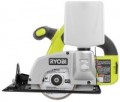Rotation speed
The maximum disc rotation speed provided by the motor of the electric tile cutter. Higher speeds are good for productivity, clean cuts and the ability to handle difficult materials, but they also require the right amount of power.
In general, if a tile cutter is bought for simple work with ordinary facing tiles (for example, repairs in an apartment), you can not pay much attention to this indicator: even the “slowest” models provide enough speed to cope with such tasks. But for cutting specific materials (for example, some types of stone), higher speeds may be required; detailed recommendations on this issue can be found in special sources.
Disc diameter
The nominal diameter of the cutting disc for which the electric tile cutter is designed. A disk of a larger diameter will simply not fit into the seat; but the use of smaller nozzles in some cases is allowed (but not recommended).
The depth of cut depends primarily on the diameter of the disc (see below). So, with ordinary tiles, having a thickness of up to 1.5 cm, almost any disc, even the smallest one, will cope; but for thicker materials (for example, paving slabs) and the appropriate tool will be needed. However it is worth noting that with the same diameter of the disc, the thickness of the cut may be different.
Also, the size of the cutting tool allows you to generally evaluate the class of the tool: the larger the disc, the more powerful and performant the tile cutter, usually.
Bore diameter
The diameter of the mounting hole on the cutting disc that the tile cutter is compatible with. This parameter is important when searching for and purchasing interchangeable working nozzles: the diameters of the mounting hole on the tile cutter and on the disk must match.
Cutting depth
The greatest depth to which the tool can cut through the material being processed, in other words, the maximum thickness of the tile that the tile cutter is guaranteed to be able to cut.
It is worth choosing a tool for this parameter taking into account the thickness of the material with which to work, plus some margin “just in case”. But this margin should not be too large: for a
deep cut, large discs and high power are required, which accordingly affects the price, weight and dimensions of the tool.
Battery voltage
Operating voltage of the battery in a device with the appropriate type of power supply (see “Power source”). The more powerful the tool, the higher the battery voltage, as a rule. At the same time, this parameter is usually selected in such a way as to optimally match the characteristics of a particular model; therefore, in practice, voltage data may only be required when looking for a spare or additional battery.
Battery capacity
Capacity of the battery supplied with the appropriate type of tile cutter (see “Power source”).
In theory, the higher the capacity, the longer the tool can work without recharging/changing the battery. However, in practice everything is not so simple. Firstly, actual autonomy depends not only on the characteristics of the battery, but also on the power consumption of the tool (and this is directly determined by the engine power). Secondly, only batteries with the same rated voltage can be compared by capacity in ampere-hours; if the voltage is different, ampere-hours must be converted to watt-hours using special formulas and using the results already obtained. So it makes sense to compare using this parameter only devices with the same battery voltage and similar motor power.
Note that many models allow operation with batteries of different capacities - it is enough that they are compatible in connectors and operating voltage.
Charger
A device for charging batteries used in a powered tool. For models supplied with such a device, the charger model may be further specified in the specifications. This information can be useful not only for finding a spare or replacement charger, but also in case the household has other cordless tools and/or batteries for them. On the other hand, many modern cordless tools come without a charger at all. This option will be optimal primarily if a compatible memory device is already available, and there is simply no need to overpay for a second device. In addition, the absence of a charger will be appreciated by those who want to choose this accessory separately, without relying on the manufacturer’s decision.
Noise level
The average noise level produced by the tile cutter during operation. Actual figures may differ from those claimed in any direction, depending on the specific material, speed of work, wear of the cutting blade, etc. However, in general, according to this indicator, it is quite possible to evaluate the loudness of the unit.
The lower the noise level, the more comfortable the work with the tile cutter, the lower the fatigue. The quietest of modern instruments give out about 60 dB — this is the level of a loud conversation at a distance of about 1 m; in the most noisy, the volume exceeds 100 dB (sound background in an industrial workshop).

